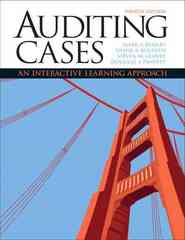Question
Unloved By: Jessica Pierce Call them the Unloved. They watch from the hallway as co-workers linger over the water cooler; they feel a tinge of
Unloved
By: Jessica Pierce
Call them the Unloved. They watch from the hallway as co-workers linger over the water cooler; they feel a tinge of indignation when the boss flirts with his secretary; they spot the boss at a restaurant on Saturday night with the new analyst, fresh out of her fancy business school degree. They harbor suspicions. The pretty analyst spends too much time in the boss's office, too much time with the door closed. When promotions and bonuses are handed out,
their suspicions are confirmed: the analyst moves ahead while they remain behind.
Until recently, the Unloved have remained in the background, the long-suffering wallflowers of workplace romance. But a recent court ruling in California has brought to light the problems of employees who suffer on the job as a result of other people's workplace romances. California's
Supreme Court ruled in July of 2005 that workers can sue when favoritism shown an employee in a sexual relationship with a supervisor creates a hostile working environment for other employees. This is an expansion of sexual harassment legislation, to include claims of harassment even if the conduct is directed at someone else.
The California case was brought by Edna Miller and Frances Mackey, both of whom worked at Valley State Prison for Women in Chowchilla, California. Miller and Mackey sued the Department of Corrections for sexual harassment and discrimination. Their complaint was that the warden, Lewis Kuykendall, had simultaneous extramarital sexual relationships with three
female employees, each of whom received unwarranted employment benefits from Kuykendall. Miller and Mackey-neither of whom was involved with Kuykendall claimed that they had been subject to harassment and discrimination because of Kuykendall's various on-the-job liaisons.
In a unanimous decision, the California justices ruled that sexual favoritism can rise
to the level of sexual harassment when it creates an environment "in which the demeaning message is conveyed to female employees that they are viewed as 'sexual playthings' or that the way required for women to get ahead in the workplace is by engaging in sexual conduct with their supervisors or the management" (Miller et al. v. Department of Corrections).
Isolated instances of sexual favoritism do not constitute discrimination on the basis on gender, race, or other legally protected characteristic, as covered under Title VII, the main antidiscrimination statute applying to the workplace. But, according to the California court, sexual favoritism can be so widespread within a workplace that it demeans women as a group, thus constituting gender-based harassment.
The issue in Miller is sexual favoritism and when such favoritism constitutes sexual harassment. But the case raises broader questions about workplace romance. Is workplace romance ever appropriate? If so, what sorts of policies should a business establish, in order to maintain a happy workforce and avoid harassment lawsuits?
One obvious solution is to have a blanket policy forbidding any and every workplace romantic relationship. Yet this approach seems unrealistic.
Managers argue that it is impossible to completely bar on-the-job relationships. People who work together spend long days together and often socialize together outside of work. Managers may want to encourage this sense of comradeship and cohesion among workerseven though it is likely to lead to romantic involvements. Indeed, many people spend so much time at work that this may be their only opportunity to search for a lifetime mate. Charles Pierce, a psychologist studying workplace romance, argues that on the job relationships can actually increase productivity, motivation, and job satisfaction (Montana State University).
So, how do we judge which workplace romances are appropriate and which are not? Who should do this judging: human resource managers, the CEO, the board of directors, or individual employees? Should there be explicit policies to guide people'sbehavior, or should things remain open to the discretion of individual managers?
Discussion Questions
Often people will distinguish ethical from unethical workplace relationships based on the following. For each, consider where you stand.
Equality of the work relationship: For many, peer-peer relationships present far fewer problems than subordinate-superior, which seem to have more potential for abuse or manipulation (the subordinate using the relationship to get ahead; the superior trading on this desire in order to get sex). It seems especially problematic, to some, when male superiors date female subordinates; though others argue that such a reaction relies on sexist stereotyping.
1. Should companies have explicit policies on co-worker dating, or is it better to leave things open?
2. Should such policies forbid superior-subordinate relationships?
3. Are women more likely than men to be exploited in sexual relationships on the job?
Motivations: Why are the individuals engaging in the relationship? Is it a desire for love, for companionship, for sex, or for some other end (perhaps a promotion)? Are the motivations "shared"? Are both in it for love or for advancement? Or is it lopsided, with one person in love while the other simply wants a promotion? Or with one dangling the promise of a promotion
over the other, in order to gain sex?
5. Is using your status to gain sex from subordinates morally wrong? Why or why not?
6. Are men more likely than women to use status to gain sex?
Marital status: Are both employees single? Or are one or both married and engaging
in an extramarital affair?
7. Is it an unwarranted intrusion into employees' private lives for company policy to explicitly forbid extramarital liaisons on the job?
Step by Step Solution
There are 3 Steps involved in it
Step: 1

Get Instant Access with AI-Powered Solutions
See step-by-step solutions with expert insights and AI powered tools for academic success
Step: 2

Step: 3

Ace Your Homework with AI
Get the answers you need in no time with our AI-driven, step-by-step assistance
Get Started



